
When Baz Luhrmann’s Moulin Rouge! came out in June of 2001, I had only been doing this column full time for about six months. I wasn’t really settled in and I wasn’t entirely comfortable in the position — especially, if someone recognized me and wanted to talk to me. (I tended to want to answer the question, “Are you Ken Hanke?” with, “That all depends.” At that point I wasn’t well-known and my picture wasn’t in the paper.) So when someone came up to me while Moulin Rouge! was still in the theater and announced, “I don’t usually like your reviews,” I could only conclude that he wasn’t a fan and that I was in for it. However his next words were, “But I want to thank you for convincing me to go see Moulin Rouge! in the theater. When people see this on video, they’re going to be kicking themselves for not seeing it on a big screen.” And he was right. Well, here we are 12 years later and those of you who missed it on the big screen have a chance to fix that — while those of us who did see it can watch it properly for the first time in ages.
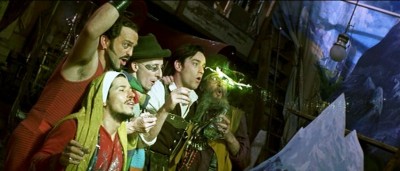
Moulin Rouge! is — as far as I’m concerned — where 21st century film begins. It is cinema writ large — a full-blown explosion of filmmaking. When it first came out, my first words on it were, “If you hate musicals, stay away. If you hate opera, run for your life. If you want to see the most intoxicating, mind-bending, dazzling, nonstop display of sheer cinematic invention in ages, then waste no time in getting to Baz Luhrmann’s Moulin Rouge!. This is The Goods. This is what filmmaking ought to be about and rarely is. This is the work of a filmmaker pushing the possibilities of film to their limits for the sheer joy of film.” Even now, I feel the same sense of excitement when I look at what Luhrmann accomplished in this film — and I saw it at least 10 times on its initial run. (It helped that I was then working at a theater and that Fox seemed disinclined to pick up the print after the run, so those of us who loved it would run it after hours for our own enjoyment.)
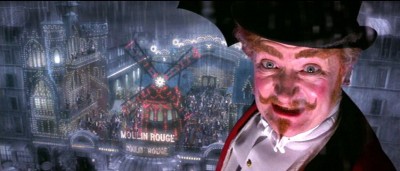
Oh, I’m not claiming that Luhrmann re-invented cinema with the film. No one really re-invents cinema. What they do is build on the history of filmmaking and use what they’ve learned in new ways that no one had thought of. In the case of Moulin Rouge!, that’s obvious from the very onset — its literal curtain-raiser opening is an adaptation of (and improvement on) the opening of Mervyn LeRoy’s Gypsy (1962). There are deliberate nods to other movies throughout the film. When Satine (Nicole Kidman) remarks to Harold Zidler (Jim Broadbent) that no one could play the villain in their show like he could, he responds, “No one’s going to.” That exchange comes from Vincente Minnelli’s The Band Wagon (1953). These things are deliberately included as nods to the films that came before this one — and which helped to fuel it.
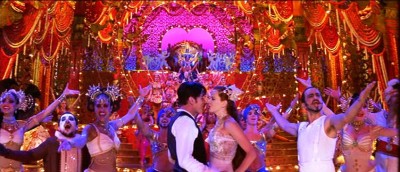
The most obvious direct influence on the film, though, is Ken Russell’s Lisztomania (1975). Where Russell’s film presents Franz Liszt and Richard Wagner as 19th century pop stars, Luhrmann presents the Bohemians of the end of that century in the same light — only perhaps more so, since he actually transports actual modern pop and rock music to 1899 (which is referred to in the film as the “summer of love”) with Marc Bolan’s “Children of the Revolution” being used as the film’s anthem. Most of the film’s wildly eclectic and anachronistic choice of songs is inspired. Cinematically, the adaptation of The Police’s “Roxanne” is perhaps the most brilliant sequence in the film. Thematically, using Queen’s “The Show Must Go On” as the song when Satine realizes she’s dying of tuberculosis carries with it the resonance of being a song written by a man who knew he was dying of AIDS.
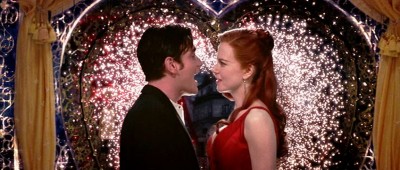
This approach is not going to be to everyone’s taste, nor is the fact — which was very much criticized at the time — that the story of Moulin Rouge! is essentially a simple blend of a “let’s put on a show” musical with La Boheme or perhaps La Traviata. But really it’s that simplicity that makes the film work — and work in a readily accessible way that Lisztomania never could. Its thematic weight isn’t great in itself, but what it means to call to mind is a time when many of us did indeed believe that all you need is love and that the world could be saved by rock music. Of course, we all know better than that now. But the question arises — are we really better off for knowing that? I’m not sure that we are — and I certainly don’t see that we’ve replaced those simplistic beliefs with anything better.
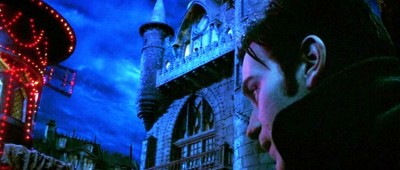
Much was made at the time of the film’s aggressive editing technique and the fact that most shots stay on the screen for five seconds or less, but that kind of rapid editing wasn’t all that new. D.W. Griffith used it in 1916. The “Pinball Wizard” sequence in Tommy manages to pack 150 shots into less than five minutes. The difference lies in the fact that no film had ever used the approach for two solid hours, but I’ve never felt that it came across as rushed or even unduly frenetic. The film moves at a pace that isn’t entirely dictated by the speed of the cuts. And — and this is key — the film’s cuts are never an incoherent jumble of images. Each shot is clearly related to the last. Each forms a part of a coherent tapestry. That this aesthetic has been co-opted by others and mangled into incoherent cutting is not the fault of Moulin Rouge!.
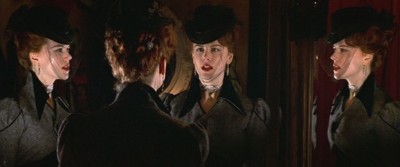
It’s worth noting that at the time the film was made, movies were being made with an eye on ancillary video sales. As a result, filmmakers were being pressured to use only the center of the frame — even if the film was being shot in true widescreen. Bear in mind that VHS was still alive and kicking in 2001, and even DVDs were being offered in so-called “full-frame” versions to fit the shape of conventional TV screens. Consumers had been resistant to letter-boxed versions of films — stubbornly refusing to recognize that, no, they weren’t getting less image, but more of it, and those nasty black bars were there so they could actually see the whole movie as it had looked in the theater. Studios wanted movies that easily adapted to the TV ratio. How he managed to get away with it, I don’t know, but Luhrmann refused to accommodate this idiotic notion and made a wide-screen film that truly was wide-screen at a time when we simply weren’t seeing such. He filled ever inch of that frame with relevant information and vibrant imagery in a way we had rarely seen since the mid-1970s when home video wasn’t an issue. It was revelatory — and it still is, because only a handful of filmmakers really use the frame this completely.
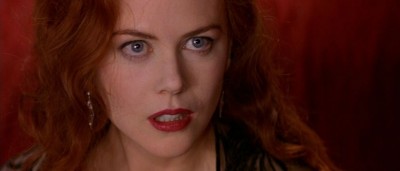
As big as the film is, for me, a lot of its resonance lies in very small moments. Prior to this film, I had not cared for Nicole Kidman. This not only changed that completely, but I can pinpoint the exact moment — when she first really hears Ewan McGregor singing Elton John’s “Your Song” — where I absolutely fell in love with her. (Pictured right.) It’s the memory of that single leaf trembling on a tree. It’s John Leguizamo’s Toulouse-Lautrec barking with joy during “Your Song” — a moment where I always think, no, that’s not real life, but wouldn’t it be so much better if it was? To me, that’s kind of how I feel about the whole film — that it’s life as I wish it was. See it on the big screen as Luhrmann meant it to be seen and find out for yourself.
The Asheville Film Society’s Big Screen Budget Series will show Moulin Rouge! Wednesday, May 8 at 7:30 p.m. in one of the downstairs theaters at The Carolina Asheville. Admission is $5 for AFS members and $7 for the general public.



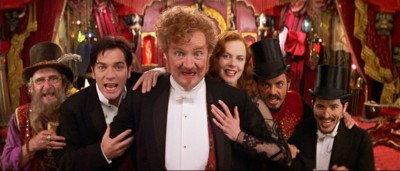
So…will Mr. Xanadon’t be able to join us for this one?
No, and I’m not happy about it. Especially since at the time of its theatrical release I –like an idiot– had this stupid notion in my head that I wouldn’t like it, who wants to spend 7 bucks to see a stupid musical, blah blah blah blah. Young and dumb.
And yet… now that I think about it, a year later I pony up to see Chicago in its opening week. Go figure.
I’ll say this is a fantastic read. I’ll now be watching Moulin Rouge! from my couch.
I was afraid you’d used up your favors. Couldn’t you have…oh, like an emergency? When I was in high school I specialized at being sick whenever something choice was on TV on a weekday morning…
It’s very kind of you to call this a fantastic read, though I hate that you won’t be there.
Okay, so I’ve had “I Hope You Don’t Mind” floating around my head (and occasionally spilling from my mouth) for a couple days now. Kind of you to join me in my hatred of me not attending on Wednesday. My recent living room TV upgrade made for a yet more impressive Moulin Rouge! viewing experience than last, but the pained wonder at what might’ve been still crowds all around.
On the plus side, I’m sending a co-worker in my stead. I’d be outrageously bitter about this, but she’s a big fan and was the lynch-pin in my being able to attend The Shining.
Is Wednesday night mass still a thing? If you guys keep up with this, I may have to fake a conversion to devout Catholicism.
Boy, are you asking the wrong person about Wed. night mass, but my suspicion is it still exists. Now, what a few Pater Nosters and Ave Marias will get you, I don’t know. We do plan on the once-a-month big screen showings, though the titles will depend a good deal on how well attended this one is. Titles like this and The Shining don’t come cheap.
By the way, I’m sitting here with an unopened Blu-ray of the film. I am saving my self for the Wed. showing before even opening it. (And it took me till just this minute to realize that “I Hope You Don’t Mind” was “Your Song.” You are lax in your Eltonia.)
The night is clear so I am coming. I’m hoping that after 10 years my expectations are not too high.
Well, if you’re ever going to be whelmed by it, this will be the way to go. I’ll be curious to see how you feel about it. By the way, how did Beyond the Valley fare?